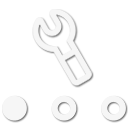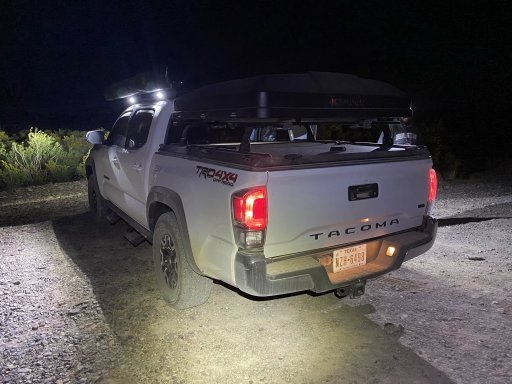
Contributor III
I'm in the process of planning out the electrical system for my '21 Tacoma TRD Off-Road and want to do the wiring right as well as leaving room for future upgrades. However, I am very new to electrical work (I've done subwoofer installs way back when I was younger for my previous cars as well as for my friends but those were from tutorials and I know I didn't do everything correct).
Foundation:
- Single Battery (will stick with a single battery as I don't think I'll need a dual battery for the foreseeable future)
- Switch-Pros SP-9100 & PowerTrays Vertical Mount/Bracket w/ a Blue Sea Fuse Box & Bus Bar (8 switches + 6 additional fused connections should cover everything I'll ever need/want and no need for relays for everything connected to the switch-pros)
The following section is what I'm stuck on.
Currently Planned:
- 6x 20W Scene/Work Lights (I'm thinking maybe 4 on the roof rack facing the sides, 2 on the bed bars facing the rear OR 2 on the roof rack facing the sides, 4 on the bed bars with 2 facing the sides and 2 facing the rear).
- 12V Socket w/ USB wired to the bed (for fridge later on) + LED Strip Cargo Lights.
Questions:
1. Are 6 20W scene lights overkill? They'll be primarily used as camp lights and I believe I can dim the lights using the switch-pros if they are too bright but they can also serve as lights when driving off-road in the dark.
2. For the wiring harness (1 for the roof rack, 1 for the bed bars), here is the math. Please correct me if I'm wrong:
- 4 lights x 20W / 12V = 6.7A therefore 16 AWG or 14 AWG should be fine depending on the length of wire.
- 2 lights x 20W / 12v = 3.4A (will use same wire gauge since I'll be ordering 50')
3. I'm planning to connect the 2 wiring harness from question 2 to the same terminal (connection? not sure what its called) on the busbar so I can control both with the same switch. Is that okay to do? or should I connect a larger gauge wire to the busbar and split off with the 2 wires going to each location?
4. The 12V Socket w/ the USB ports are rated for 120W. The fridge I'll be purchasing is the Dometic CFX3 75DZ which is rated for 9.6A or roughly 115W (if my math is correct). If the fridge is running at max draw and I have 2 devices plugged into the USB Ports, would there be a chance of a fire/wire melting? or will one of the outputs just not be sufficiently powered? to follow up, could I just use a thicker gauge wire with the socket to allow for more current?
5. For the wiring to the bed. Please correct me if I'm wrong:
- 10A (Fridge) + 6.5A (USB Ports per Amazon description "Output of each usb port : DC 3.6-6.5V/3A, 6.5V-9V/2A, 9V-12V/1.5A") + 2A (24W LED Strip) = 18.5A therefore 12 AWG or 10 AWG power and ground wire depending on length of wire then use two 14 AWG wire to the 12V socket & Led Lights
6. Should I go with the largest possible gauge (probably 4 AWG) between the battery and switch-pros/blue sea busbar since I'm already at 28.5A (at max draw) for these alone? Keep in mind that in the future, I'm planning to install a compressor, roof rack spot lights (KC Hilites Gravity Pro6), ditch lights, bumper lights, chase bar.
I've researched before posting but it will give me peace of mind hearing answers to my specific questions.
Links:
Switch-Pros: SP-9100 Switch Panel Power System
PowerTrays Mount: Switch-Pros PowerTray > Tacoma > TRD Off Road/Pro
BlueSea Bundle: Accessory Bundle for Switch-Pro PowerTray > Toyota
20W 4WDKing LED Lights: Link
12v Socket & USB: Link
LED Light Strip (for reference): Link
Blue Sea Wire Selection Reference: http://assets.bluesea.com/files/resources/newsletter/images/DC_wire_selection_chartlg.jpg
Foundation:
- Single Battery (will stick with a single battery as I don't think I'll need a dual battery for the foreseeable future)
- Switch-Pros SP-9100 & PowerTrays Vertical Mount/Bracket w/ a Blue Sea Fuse Box & Bus Bar (8 switches + 6 additional fused connections should cover everything I'll ever need/want and no need for relays for everything connected to the switch-pros)
The following section is what I'm stuck on.
Currently Planned:
- 6x 20W Scene/Work Lights (I'm thinking maybe 4 on the roof rack facing the sides, 2 on the bed bars facing the rear OR 2 on the roof rack facing the sides, 4 on the bed bars with 2 facing the sides and 2 facing the rear).
- 12V Socket w/ USB wired to the bed (for fridge later on) + LED Strip Cargo Lights.
Questions:
1. Are 6 20W scene lights overkill? They'll be primarily used as camp lights and I believe I can dim the lights using the switch-pros if they are too bright but they can also serve as lights when driving off-road in the dark.
2. For the wiring harness (1 for the roof rack, 1 for the bed bars), here is the math. Please correct me if I'm wrong:
- 4 lights x 20W / 12V = 6.7A therefore 16 AWG or 14 AWG should be fine depending on the length of wire.
- 2 lights x 20W / 12v = 3.4A (will use same wire gauge since I'll be ordering 50')
3. I'm planning to connect the 2 wiring harness from question 2 to the same terminal (connection? not sure what its called) on the busbar so I can control both with the same switch. Is that okay to do? or should I connect a larger gauge wire to the busbar and split off with the 2 wires going to each location?
4. The 12V Socket w/ the USB ports are rated for 120W. The fridge I'll be purchasing is the Dometic CFX3 75DZ which is rated for 9.6A or roughly 115W (if my math is correct). If the fridge is running at max draw and I have 2 devices plugged into the USB Ports, would there be a chance of a fire/wire melting? or will one of the outputs just not be sufficiently powered? to follow up, could I just use a thicker gauge wire with the socket to allow for more current?
5. For the wiring to the bed. Please correct me if I'm wrong:
- 10A (Fridge) + 6.5A (USB Ports per Amazon description "Output of each usb port : DC 3.6-6.5V/3A, 6.5V-9V/2A, 9V-12V/1.5A") + 2A (24W LED Strip) = 18.5A therefore 12 AWG or 10 AWG power and ground wire depending on length of wire then use two 14 AWG wire to the 12V socket & Led Lights
6. Should I go with the largest possible gauge (probably 4 AWG) between the battery and switch-pros/blue sea busbar since I'm already at 28.5A (at max draw) for these alone? Keep in mind that in the future, I'm planning to install a compressor, roof rack spot lights (KC Hilites Gravity Pro6), ditch lights, bumper lights, chase bar.
I've researched before posting but it will give me peace of mind hearing answers to my specific questions.
Links:
Switch-Pros: SP-9100 Switch Panel Power System
PowerTrays Mount: Switch-Pros PowerTray > Tacoma > TRD Off Road/Pro
BlueSea Bundle: Accessory Bundle for Switch-Pro PowerTray > Toyota
20W 4WDKing LED Lights: Link
12v Socket & USB: Link
LED Light Strip (for reference): Link
Blue Sea Wire Selection Reference: http://assets.bluesea.com/files/resources/newsletter/images/DC_wire_selection_chartlg.jpg







